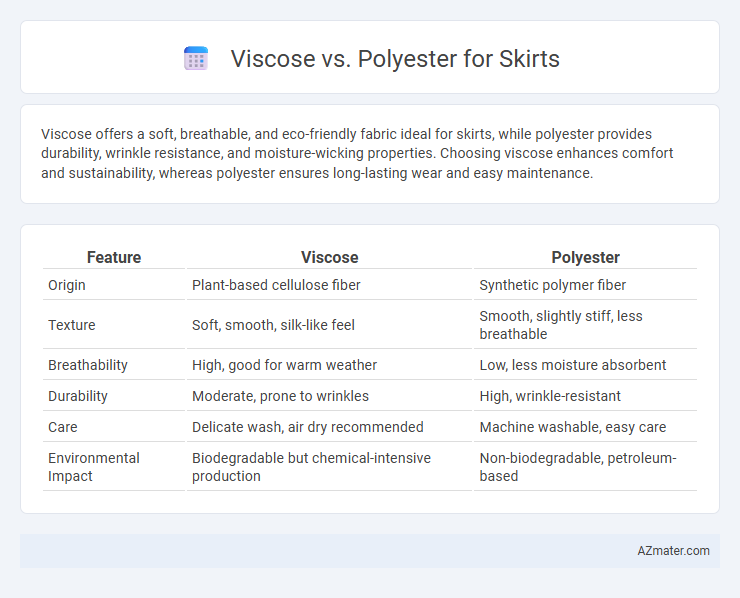Viscose offers a soft, breathable, and eco-friendly fabric ideal for skirts, while polyester provides durability, wrinkle resistance, and moisture-wicking properties. Choosing viscose enhances comfort and sustainability, whereas polyester ensures long-lasting wear and easy maintenance.
Table of Comparison
| Feature | Viscose | Polyester |
|---|---|---|
| Origin | Plant-based cellulose fiber | Synthetic polymer fiber |
| Texture | Soft, smooth, silk-like feel | Smooth, slightly stiff, less breathable |
| Breathability | High, good for warm weather | Low, less moisture absorbent |
| Durability | Moderate, prone to wrinkles | High, wrinkle-resistant |
| Care | Delicate wash, air dry recommended | Machine washable, easy care |
| Environmental Impact | Biodegradable but chemical-intensive production | Non-biodegradable, petroleum-based |
Introduction to Viscose and Polyester Fabrics
Viscose fabric, derived from natural cellulose fibers, offers a soft, breathable texture ideal for lightweight skirts that drape elegantly. In contrast, polyester, a synthetic fabric made from petrochemicals, provides durability, wrinkle resistance, and vibrant color retention commonly favored for skirts requiring longevity and shape retention. Understanding the distinct fiber structures of viscose and polyester helps in choosing skirts that balance comfort, aesthetics, and maintenance preferences.
Key Differences Between Viscose and Polyester
Viscose is a semi-synthetic fiber made from natural cellulose, offering a soft, breathable, and moisture-absorbent fabric ideal for skirts in warm weather, while polyester is a fully synthetic fiber known for durability, wrinkle resistance, and quick drying. Viscose tends to have a smoother, silk-like texture and drapes elegantly, whereas polyester provides more stretch and retains shape well over time. Skirts made from viscose require delicate care due to their tendency to wrinkle and shrink, contrasting with the low-maintenance, colorfast properties of polyester skirts.
Texture and Feel: Comfort Comparison
Viscose skirts offer a soft, breathable texture that mimics natural fibers, providing exceptional comfort and moisture absorption ideal for warm weather. Polyester skirts feature a smooth, slightly shiny surface that resists wrinkles but can trap heat and feel less breathable, potentially reducing overall comfort during extended wear. Choosing between viscose and polyester depends on prioritizing natural softness and ventilation versus durability and wrinkle resistance in skirt fabrics.
Breathability and Moisture Management
Viscose fabric offers superior breathability compared to polyester, allowing better air circulation which keeps the skin cool and dry during wear. Polyester, while less breathable, excels in moisture-wicking by quickly drawing sweat away from the body and drying faster than viscose. Choosing between viscose and polyester skirts depends on the need for natural ventilation versus efficient moisture management during physical activities.
Durability and Longevity for Skirts
Polyester skirts offer superior durability and longevity compared to viscose, thanks to their resistance to wrinkles, shrinking, and stretching. Viscose, while breathable and soft, tends to weaken with frequent washing and exposure to moisture, reducing its lifespan. For long-lasting skirts, polyester's ability to maintain color and structure over time makes it a more durable choice.
Care, Cleaning, and Maintenance
Viscose skirts require gentle hand washing or delicate machine cycles to prevent fiber damage, and they should be air-dried to maintain fabric integrity, while polyester skirts are more durable, allowing for regular machine washing and faster drying without shrinking. Viscose fibers tend to wrinkle easily and may lose shape if not handled properly, whereas polyester resists wrinkles and retains its form with minimal ironing required. Proper care for viscose includes avoiding high heat and harsh detergents, contrasting with polyester's tolerance for higher temperatures and more robust cleaning products.
Sustainability and Environmental Impact
Viscose skirts are made from regenerated cellulose fibers derived from wood pulp, offering biodegradability but involving chemically intensive production processes that can contribute to deforestation and water pollution. Polyester skirts, produced from non-renewable petroleum-based resources, have a significant carbon footprint and persistence in the environment due to their non-biodegradable nature, leading to microplastic pollution. Choosing skirts made from recycled polyester can reduce environmental impact, while sustainably sourced viscose from certified forests offers a more eco-friendly alternative within textile production.
Best Occasions for Viscose Skirts
Viscose skirts are ideal for warm-weather events due to their breathability and lightweight feel, making them perfect for casual outings, garden parties, and daytime gatherings. The fabric's excellent drape and soft texture enhance comfort and style, suited for office wear and semi-formal occasions where a polished yet breathable outfit is needed. Viscose skirts excel in scenarios requiring moisture absorption and airflow, providing a cooler option compared to polyester skirts, which are better suited for colder climates or activities demanding durability and wrinkle resistance.
Best Uses for Polyester Skirts
Polyester skirts excel in durability, wrinkle resistance, and color retention, making them ideal for everyday wear and active lifestyles. Their moisture-wicking properties and quick-drying nature suit outdoor activities and travel. Polyester's versatility allows for various styles, from casual to formal, providing low-maintenance options suitable for busy schedules.
Choosing the Right Fabric: Viscose vs Polyester for Your Skirt
Viscose offers a soft, breathable feel with excellent drape, making it ideal for skirts that require fluid movement and comfort. Polyester provides durability, wrinkle resistance, and color retention, suitable for skirts needing structure and easy maintenance. Selecting between viscose and polyester depends on your preference for natural-like softness versus long-lasting fabric performance.

Infographic: Viscose vs Polyester for Skirt
 azmater.com
azmater.com